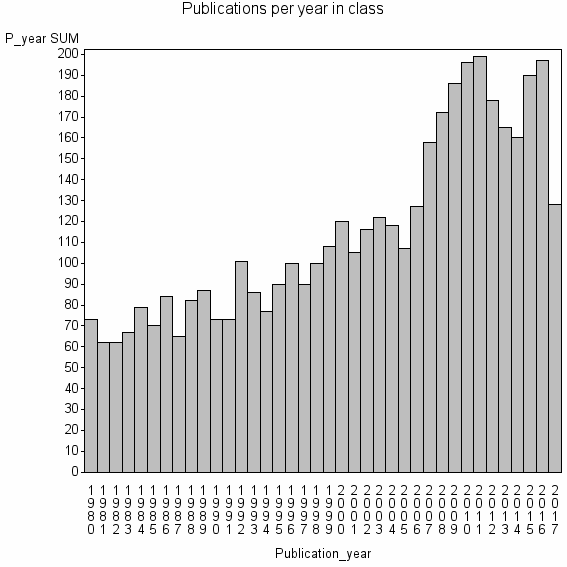
Class information for: |
Basic class information |

Hierarchy of classes |
The table includes all classes above and classes immediately below the current class. |
| Cluster id | Level | Cluster label | #P |
|---|---|---|---|
| 10 | 4 | IMMUNOLOGY//TRANSPLANTATION//RHEUMATOLOGY | 1369268 |
| 428 | 3 | OTORHINOLARYNGOLOGY//CHRONIC RHINOSINUSITIS//SINUSITIS | 28857 |
| 2425 | 2 | ESTHESIONEUROBLASTOMA//OLFACTORY NEUROBLASTOMA//INVERTED PAPILLOMA | 4373 |
| 4584 | 1 | ESTHESIONEUROBLASTOMA//OLFACTORY NEUROBLASTOMA//CRANIOFACIAL RESECTION | 1787 |
| 13395 | 1 | INVERTED PAPILLOMA//ANTROCHOANAL POLYP//SINONASAL PAPILLOMA | 871 |
| 13797 | 1 | JUVENILE NASOPHARYNGEAL ANGIOFIBROMA//ANGIOFIBROMA//JUVENILE ANGIOFIBROMA | 842 |
| 14900 | 1 | EXTRAORAL IMPLANTS//MAXILLOFACIAL PROSTHESIS//CRANIOFACIAL IMPLANTS | 769 |
| 36018 | 1 | NASAL VESTIBULE//SQUAMOUS CELL CARCINOMA OF THE NASAL VESTIBULE//ARGON THERAPEUTIC USE | 104 |
Terms with highest relevance score |
| rank | Category | termType | chi_square | shrOfCwithTerm | shrOfTermInClass | termInClass |
|---|---|---|---|---|---|---|
| 1 | ESTHESIONEUROBLASTOMA | authKW | 1367190 | 5% | 91% | 208 |
| 2 | OLFACTORY NEUROBLASTOMA | authKW | 1094084 | 4% | 85% | 179 |
| 3 | INVERTED PAPILLOMA | authKW | 1065119 | 5% | 73% | 202 |
| 4 | JUVENILE NASOPHARYNGEAL ANGIOFIBROMA | authKW | 633572 | 2% | 91% | 97 |
| 5 | CRANIOFACIAL RESECTION | authKW | 541861 | 2% | 81% | 93 |
| 6 | ANGIOFIBROMA | authKW | 478943 | 3% | 60% | 110 |
| 7 | JUVENILE ANGIOFIBROMA | authKW | 259576 | 1% | 97% | 37 |
| 8 | EXTRAORAL IMPLANTS | authKW | 252919 | 1% | 95% | 37 |
| 9 | SINONASAL UNDIFFERENTIATED CARCINOMA | authKW | 249077 | 1% | 79% | 44 |
| 10 | ANTROCHOANAL POLYP | authKW | 243527 | 1% | 87% | 39 |
Web of Science journal categories |
| chi_square_rank | Category | chi_square | shrOfCwithTerm | shrOfTermInClass | termInClass |
|---|---|---|---|---|---|
| 1 | Otorhinolaryngology | 183807 | 43% | 1% | 1886 |
| 2 | Dentistry, Oral Surgery & Medicine | 13875 | 14% | 0% | 631 |
| 3 | Surgery | 10637 | 28% | 0% | 1203 |
| 4 | Oncology | 1316 | 11% | 0% | 481 |
| 5 | Clinical Neurology | 1277 | 9% | 0% | 389 |
| 6 | Radiology, Nuclear Medicine & Medical Imaging | 1214 | 8% | 0% | 334 |
| 7 | Pathology | 985 | 5% | 0% | 211 |
| 8 | Medicine, Research & Experimental | 956 | 7% | 0% | 293 |
| 9 | Neuroimaging | 349 | 1% | 0% | 55 |
| 10 | Pediatrics | 49 | 2% | 0% | 98 |
Address terms |
| chi_square_rank | term | chi_square | shrOfCwithTerm | shrOfTermInClass | termInClass |
|---|---|---|---|---|---|
| 1 | OTOLARYNGOL HEAD NECK SURG | 51610 | 12% | 1% | 516 |
| 2 | MAXILLO IAL PROSTHET SERV | 45100 | 0% | 52% | 12 |
| 3 | OTOLARYNGOL | 35731 | 10% | 1% | 434 |
| 4 | HEAD NECK SURG | 31145 | 4% | 3% | 160 |
| 5 | CRANIO IAL PROSTHET UNIT | 25934 | 0% | 60% | 6 |
| 6 | OTORHINOLARYNGOL HEAD NECK SURG | 24983 | 5% | 2% | 224 |
| 7 | OTORHINOLARYNGOL | 24945 | 6% | 1% | 275 |
| 8 | OTOLARYNGOL FUJIAN PROV | 23055 | 0% | 80% | 4 |
| 9 | KATEDRA ODDZIAL KLIN NEUROCHIRURG SOSNOWCU | 21616 | 0% | 100% | 3 |
| 10 | SURG NAV | 21616 | 0% | 100% | 3 |
Journals |
| chi_square_rank | term | chi_square | shrOfCwithTerm | shrOfTermInClass | termInClass |
|---|---|---|---|---|---|
| 1 | JOURNAL OF PROSTHETIC DENTISTRY | 57816 | 6% | 3% | 260 |
| 2 | LARYNGOSCOPE | 35315 | 6% | 2% | 257 |
| 3 | HEAD AND NECK-JOURNAL FOR THE SCIENCES AND SPECIALTIES OF THE HEAD AND NECK | 35196 | 4% | 3% | 157 |
| 4 | AMERICAN JOURNAL OF RHINOLOGY | 26691 | 2% | 5% | 69 |
| 5 | SKULL BASE-AN INTERDISCIPLINARY APPROACH | 22300 | 1% | 8% | 37 |
| 6 | RHINOLOGY | 21600 | 1% | 5% | 56 |
| 7 | OTOLARYNGOLOGY-HEAD AND NECK SURGERY | 18853 | 4% | 2% | 163 |
| 8 | JOURNAL OF LARYNGOLOGY AND OTOLOGY | 18236 | 4% | 2% | 154 |
| 9 | SKULL BASE SURGERY | 16324 | 1% | 8% | 29 |
| 10 | JOURNAL OF NEUROLOGICAL SURGERY PART B-SKULL BASE | 14249 | 1% | 7% | 28 |
Author Key Words |
Core articles |
The table includes core articles in the class. The following variables is taken into account for the relevance score of an article in a cluster c: (1) Number of references referring to publications in the class. (2) Share of total number of active references referring to publications in the class. (3) Age of the article. New articles get higher score than old articles. (4) Citation rate, normalized to year. |
Classes with closest relation at Level 2 |